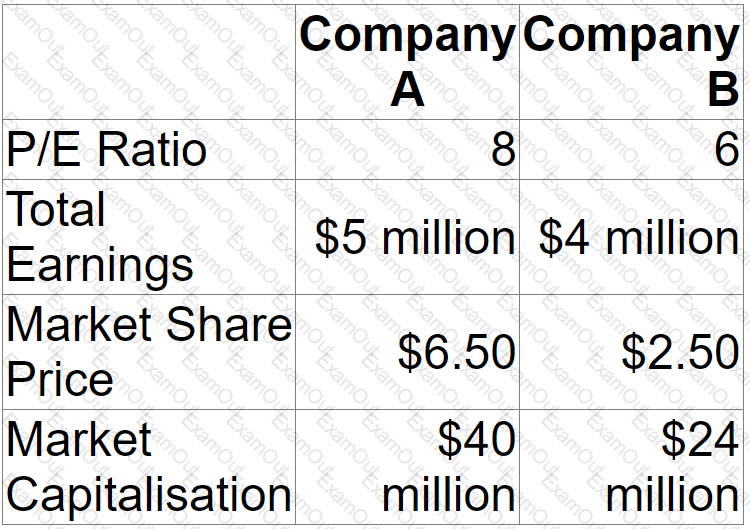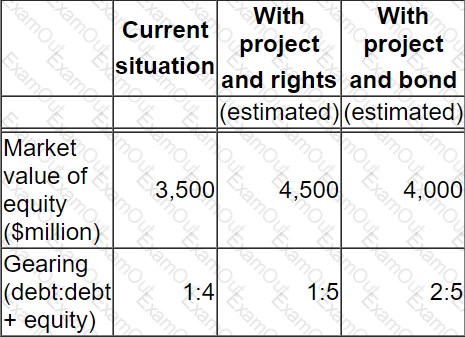An unlisted company which is owned and managed by its original founders has accumulated excess cash following many years of profitable trading.
The Board of Directors is comprised of the four original founders who each hold 25% of the equity share capital.
Which THREE of the following will be significant considerations when deciding on the company's dividend policy?
Listed Company A has prepared a valuation of an unlisted company. Company B. to achieve vertical integration Company A is intending to acquire a controlling interest in the equity of Company B and therefore wants to value only the equity of Company B.
The assistant accountant of Company A has prepared the following valuation of Company B's equity using the dividend valuation model (DVM):
Where:
• S2 million is Company B's most recent dividend
• 5% is Company B's average dividend growth rate over the last 5 years
• 10% is a cost of equity calculated using the capital asset pricing model (CAPM), based on the industry average beta factor

Which THREE of the following are valid criticisms of the valuation of Company B's equity prepared by the assistant accountant?
A listed company is planning to raise $21.6 million to finance a new project with a positive net present value of $5 million. The finance is to be raised via a rights issue at a 10% discount to the current share price. There are currently 100 million shares in issue, trading at $2.00 each.
Taking the new project into account, what would the theoretical ex-rights price be?
Give your answer to two decimal places.
$ ?
Company U has made a bid for the entire share capital of Company B.
Company U is offering the shareholders in Company B the option of either a share exchange or a cash alternative.
Advise the shareholders in Company B which THREE of the following would be considered disadvantages of accepting the cash consideration?
Company C is a listed company. It is currently considering the acquisition of Company D. The original founder of Company C currently owns 52% of the shares.
Alternative forms of consideration for Company D being considered are as follows:
• Cash payment, financed by new borrowing
• issue of new shares in Company C
Which of the following is an advantage of a cash offer over a share-for exchange from the viewpoint of the original founder of Company C?
Company H is considering the valuation of an unlisted company which it hopes to acquire.
It has obtained the target company's financial statements.
Company H has been advised that the book value of net assets as shown in the financial statements of the target company does not provide a reliable indicator of their true value.
Advise the Board of Directors which of the following THREE statements are disadvantages of the net asset basis of valuation?
Select the most appropriate divided for each of the following statements:

The Board of Directors of a listed company wish to estimate a reasonable valuation of the entire share capital of the company in the event of a takeover bid.
The company's current profit before taxation is $10 0 million.
The rate of corporate tax is 20%.
The average P/E multiple of listed companies in the same industry is 10 times current earnings.
The P/E multiple of recent takeovers in the same industry have ranged from 11 times to 12 times current earnings.
The average P/E multiple of the top 100 companies on the stock market is 16 times current earnings.
Advise the Board of Directors which of the following is a reasonable estimate of a range of values of the entire share capital in the event of a bid being made for the whole company?
Company A is planning to acquire Company B.
Company A's managers think they can improve the performance of Company B to the extent that its own P/E ratio should be applied to Company B's earnings.
Relevant Data:

What is the expected synergy if the acquisition goes ahead?
Give your answer to the nearest $ million.
$ ? million
A listed company plans to raise $350 million to finance a major expansion programme.
The cash flow projections for the programme are subject to considerable variability.
Brief details of the programme have been public knowledge for a few weeks.
The directors are considering two financing options, either a rights issue at a 20% discount to current share price or a long term bond.
The following data is relevant:

The company's share price has fallen by 5% over the past 3 months compared with a fall in the market of 3% over the same period.
The directors favour the bond option.
However, the Chief Accountant has provided arguments for a rights issue.
Which TWO of the following arguments in favour of a right issue are correct?


